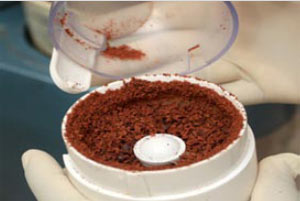 |
 |
 |
|
August 2010
|
The house of cocoaBy Frances Bekele
CRU manages one of the largest (2300 accessions) and most diverse collections of cacao germplasm in the world, namely the International Cocoa Genebank, Trinidad (ICG,T) at Centeno, Trinidad. The ICG,T contains primary germplasm from nine collection expeditions that aimed to obtain wild material from six countries including Peru, Ecuador and Colombia, regarded as the centre of diversity for cocoa. It is one of only two international depositories of cacao germplasm in the world that are in the public domain. CRU has maintained to date a multi-disciplinary research programme in conservation, characterisation, evaluation and utilisation (germplasm enhancement) of cacao genetic resources. Promising genotypes, which combine good yield potential with resistance to Black Pod and Witches’ Broom diseases, have been developed under germplasm enhancement programmes at the CRU. The enhanced populations can be used by plant breeders in Trinidad and Tobago and other cocoa producing countries as a source of resistance genes towards developing locally adapted commercial cacao varieties. This will negate the need for heavy use of fungicides that are expensive, may pose risks to human health and are often deleterious for the environment, and will thus facilitate more sustainable cocoa production systems. Utilisation of the genetic resources conserved in the ICG,T benefits the local and international cocoa industries. CRU’s research activities are currently funded by the Government of Trinidad and Tobago and international partners, and are mainly collaborative in nature. The ICG,T is a national and international natural heritage collection, and The UWI, CRU is privileged to be involved with its conservation. To find out more about the Cocoa Research Unit, please see the April 2009 issue of UWI Today Photos: Andrea Da Silva |

 In 1930, cocoa research was initiated under the Imperial College of Tropical Agriculture, and since then, Trinidad and Tobago has been seen as a source of new cocoa production technology. In 1955, the Regional Research Centre was specially established to devote more time to improving cocoa production. The research scheme continued uninterrupted until 1963 when the Cocoa Research Unit (CRU) at The UWI was established. In the intervening years, major studies were conducted on agronomy, breeding and genetics, nutrition, propagation, screening for Witches’ Broom and wilt diseases, physiology, and fermentation, among other areas. The results of the various research activities at CRU are well documented and have been of enormous value to cocoa researchers worldwide.
In 1930, cocoa research was initiated under the Imperial College of Tropical Agriculture, and since then, Trinidad and Tobago has been seen as a source of new cocoa production technology. In 1955, the Regional Research Centre was specially established to devote more time to improving cocoa production. The research scheme continued uninterrupted until 1963 when the Cocoa Research Unit (CRU) at The UWI was established. In the intervening years, major studies were conducted on agronomy, breeding and genetics, nutrition, propagation, screening for Witches’ Broom and wilt diseases, physiology, and fermentation, among other areas. The results of the various research activities at CRU are well documented and have been of enormous value to cocoa researchers worldwide.